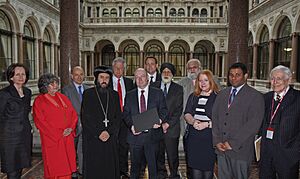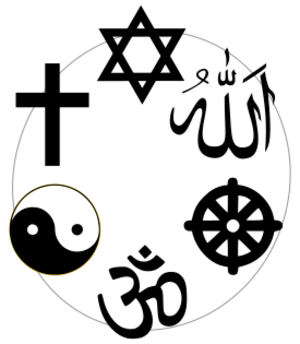World religions facts for kids
World religions is a way to group some of the largest and most important religions around the globe. These religions are often studied together because they have spread widely or have greatly influenced societies, especially in Western countries. The main ones always included are Islam, Judaism, Christianity, Hinduism, and Buddhism. Sometimes, other religions like Sikhism and Shinto are also added to this group.
This idea of "world religions" helps scholars study different faiths. It is often compared to other groups like folk religions (local traditions), Indigenous religions (native beliefs), and new religious movements (newer faiths).
The idea of "world religions" started in the United Kingdom in the 1960s. Scholars like Ninian Smart helped develop it. The main goal was to study more than just Christianity. It aimed to include other big religious traditions from all over the world. This way of thinking is often used by teachers in universities and schools. It has also changed how religions are grouped, for example, in official surveys like censuses.
However, some experts have criticized this idea since the late 1900s. They say it might not be the best way to understand all religions. Some critics argue that it uses Protestant Christianity as the main example of what a "religion" should be. They also say it might not fully understand how different religions connect. But many still find it useful for teaching, as long as students know it is just one way to group religions.
What Are World Religions?
Experts Christopher R. Cotter and David G. Robertson say the "World Religions Paradigm" is a way to think about religions. It organizes them into separate traditions that are important globally. It usually includes the "Big Five" religions. These are Buddhism, Christianity, Hinduism, Islam, and Judaism.
The "Big Five" are often listed in a specific order. The three largest Abrahamic religions—Christianity, Judaism, and Islam—usually come first. Then come Hinduism and Buddhism. Sometimes, other major religious groups are also added. These can include the Baháʼí Faith, Sikhism, or Zoroastrianism.

Including Judaism in the "Big Five" can be a bit tricky. It is on the list because it greatly influenced Christianity and Islam. It is also important for understanding Western history. However, there are far fewer Jews in the world than Christians, Muslims, Hindus, or Buddhists. Also, Judaism has not historically tried to spread its faith to other people.
Many scholars use the "world religions" group along with other categories. These include "new religious movements" and "Indigenous religions." Scholar Steven J. Sutcliffe compared these groups to a sports league. The "world religions" are like the top team. The "new" religions are in the middle, and "Indigenous" religions are in a lower division. However, scholar Graham Harvey believes all religions should be treated with the same respect.
How the Idea Started
The idea of "world religions" is closely linked to how we study religion in schools and universities. It came from a way of studying religion that focused on describing faiths. It did not focus as much on deeply analyzing them.
This idea became part of education thanks to scholars like Ninian Smart. He helped create a group in 1969 to focus on world religions in education. The goal was to teach about more than just Christianity in Western schools. However, it often looked at other religions through a Christian viewpoint. For example, it often focused on a religion's main beliefs, like Christianity does. It also saw different religions as completely separate groups. This idea came from the way people thought in Britain in the 1960s.
Today, this idea of "world religions" is used beyond just academic studies. It shapes how many people see different religious groups. For example, in the British education system, students learn about Christianity. By a certain age, they also learn about five other main religions. These are Buddhism, Hinduism, Islam, Judaism, and Sikhism.
Also, in many countries, official surveys (censuses) ask people to pick only one religion. But in real life, many people might follow practices from different traditions at the same time. This idea of having only one religious identity is not just a Western idea. For example, some people in South Asia mix Hindu and Buddhist practices. But some Hindu nationalists still see Hinduism and Buddhism as completely separate.
Scholars Tara Baldrick-Morrone, Michael Graziano, and Brad Stoddard said that the "world religions" idea is not naturally true. But it seems important because it looks like it is.
See also
- Comparative religion
- Baháʼí Faith and the unity of religion
- Buddhism and other religions
- Christianity and other religions
- Hinduism and other religions
- Islam and other religions
- Judaism and other religions
- Indian religions
- List of religious populations
- Major religious groups
- Religious pluralism
- Religious war
- Sociology of religion
- Three Persian religions


